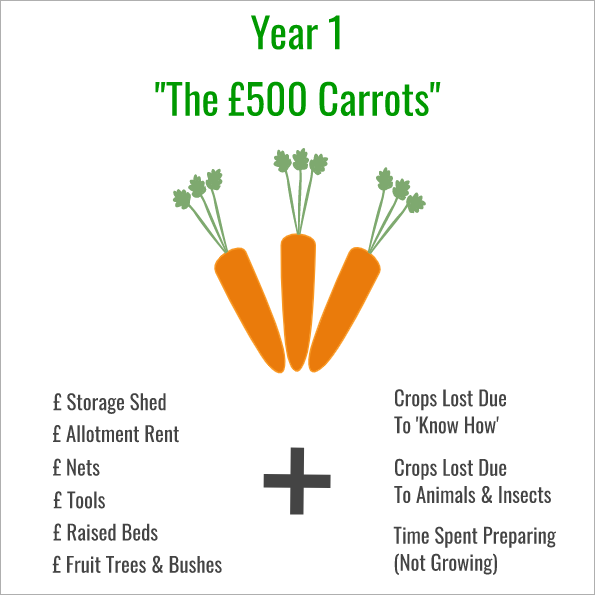Does An Allotment Save Money?


Introduction
Whilst it is possible to grow wheelbarrows full of potatoes on an allotment, does having an allotment save money overall?
Step By Step Video
YouTube Video
The short answer is an unequivocal “no”, at least in the first year or two, unless the plot holder wants to do every job by hand and forego all the labour saving tools and equipment that make working a plot an enjoyable experience.
That is the bad news over with. What I believe is more important is the life experience, and enjoyment, from being outdoors and learning about nature, and how it can change the way we look upon our world. This is the magic of having an allotment. It promotes a sustainable way of living, and arguably, the impact to society of living unsustainably will come at a much higher cost. It is just at the individual level, and certainly at the start, it is likely an allotment holder will spend more on their plot than they will save on their food bill.
I will try to explain more about the magic of allotmenting, but first I will lay out the bare facts of the financial case for working an allotment and why it is unlikely to save money.
You may also like to see my YouTube video on the best vegetables to grow to save money.
The Investment Cost
Investing in esential allotment tools and equipment will most likely set a new plot holder back at least £200 to get going. On top of this, an allotment holder needs to buy seeds, pay their allotment rent, and miscellaneous extras like nets to protect crops against birds, canes and supports, any fruit bushes they would like to buy, compost for potting up seedlings, seed trays and plugs, plastic growhouses to help seedlings get started, and so on.
The bottom line is that £500 can disappear very quickly – and that amount of money spent on fruit and vegetables at a supermarket goes a long way. This does not include other investments a gardener may wish to make. Constructing no dig beds, a polytunnel, a wooden shed, and even an automatic watering system. These investments help to put a smile on an allotment holder’s face, save physical exertion, and make the whole experience much more enjoyable.

Of course, if Grandpa or Grandma wants to retire and second hand tools are available, then many of the costs for essential tools are avoidable. However, for many, this option may not be available.
Apart from the investment cost, there is also the issue of time. The time an allotment holder spends on the plot could be time spent working at a paid job. I would suggest it to be highly unlikely that a home gardener can grow the equivalent of what they would earn for the same number of hours.
There is also the important issue of when food is available. To state the obvious, we need food every day. Growing your own fruit and vegetables takes time. I love my fruit bushes. They deliver a glut of fruit from June to September that is expensive to buy in supermarkets – a clear money saver in those months. Nevertheless, most often an allotment produces a glut of produce in months when food is cheaper in the shops, followed by scarcity in the winter months when prices are higher. This is especially true for a novice plot holder, someone who needs to learn growing cycles and what to grow, and when, to have food available all year round.
Is it possible to store a summer harvest and save money all year round? Well yes!, but pots and jars for chutney and jams, sugar, complementary spices and herbs, vinegar, power for cooking – the cost of all these things adds up, and storing and preserving things takes time.
My argument is that growing food costs money. It is a hobby that requires investment. The investment will repay itself in many ways: health and fitness, pleasure, new friendships, giving children the opportunity to play and learn about growing food, and saving money at harvest time.
Rather than focusing on self-sufficiency and saving money as an an objective, it may be better to see having an allotment as an opportunity to learn something new, experience nature, and attempt to grow varieties of fruit and vegetables that are less easy to find in the shops. You will have a edible reward for all your efforts, and have the reassurance of knowing exactly how your food was produced.
From the third year onwards, after experimenting and learning, a gardener may be considerably more successful. Most of the investments in tools and equipment will likely have been made, leaving only the annual cost of purchasing seeds. The lessons of not planting seeds in cold soil, protection from frosts, how to keep pigeons, rabbits, and squirrels away from crops, the right watering routine for plants, and other learnings will have been made. Weather can still ruin even the best laid plans, but it is likely a dedicated gardener will bring home a good harvest as a reward for their hard work.
Featured
The easy way for a gardener to organise their growing and discover gardening ideas.

